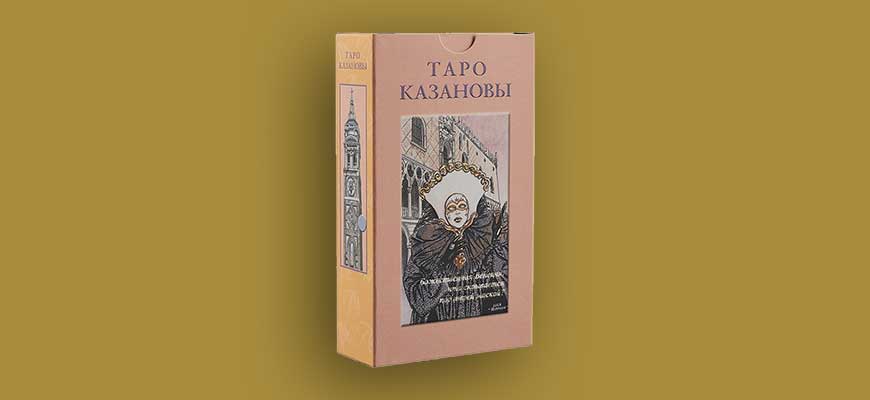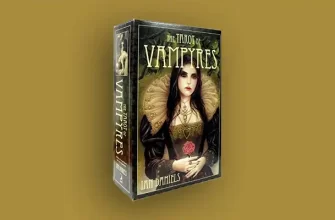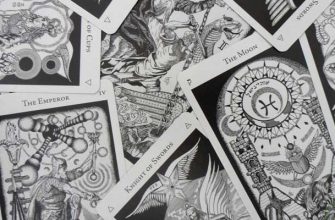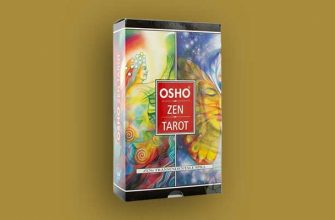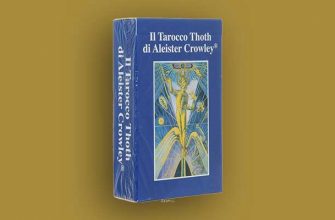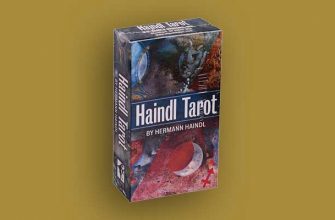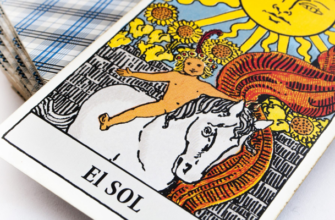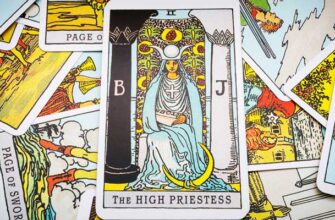Despite the fact that Tarot Manara remains my favorite deck for watching love relationships, I have worked with other similar themed instruments. One of them is Tarot Casanova – a deck that we will talk about today. Who has not heard at least once about the adventures of the world famous Italian adventurer, whose name has already become a household name – Giacomo Casanova? It is his romantic adventures that the eponymous deck is dedicated to.
History of Deck Creation
Despite the fact that the Casanova Tarot is considered a fairly “young” deck, nevertheless, its first edition took place twenty years ago – back in 2000. Yes, this, of course, is not the Tarot of Aleister Crowley , released in the late 70s, and created generally several decades earlier, but the erotic Tarot of Casanova cannot be called a completely “remake” … The illustrations based on the adventures of the famous Venetian were created by the artist Luca Raimondo, the author of the deck was made by Mario Pignatello. These cards were reprinted three times – in 2008, 2010 and 2019. The first editions were distinguished by a shirt: it depicted Venetian masks, which in newer versions were replaced by the full-length figure of Casanova himself. The general appearance of the illustrations has also slightly changed: instead of white frames and the names of each card in four languages, the frames turned black, and the publishers left only the numbers of the Arcana, which seemed to many beginners not very convenient, since it turned out to be quite difficult to determine what kind of number card in front of you, without looking closely at the picture. With the Elders, the matter was a little simpler, since in the first version they were also numbered in Roman numerals. As for the feel of use: those versions of the original Italian cards from Lo Scarabeo, where the frames were white, felt a little tighter to the touch (I have had experience with two versions of the deck). I can’t say anything about the Russian-language editions, as I prefer the Italian originals. turned out to be quite difficult. With the Elders, the matter was a little simpler, since in the first version they were also numbered in Roman numerals. As for the feel of use: those versions of the original Italian cards from Lo Scarabeo, where the frames were white, felt a little tighter to the touch (I have had experience with two versions of the deck). I can’t say anything about the Russian-language editions, as I prefer the Italian originals. turned out to be quite difficult. With the Elders, the matter was a little simpler, since in the first version they were also numbered in Roman numerals. As for the feel of use: those versions of the original Italian cards from Lo Scarabeo, where the frames were white, felt a little tighter to the touch (I have had experience with two versions of the deck). I can’t say anything about the Russian-language editions, as I prefer the Italian originals.
Key Features
The most important feature of Tarot Casanova is its love orientation, but I will tell you more about this when considering symbolism. The rest of the deck follows the classic traditions: there are exactly 78 cards, four suits and they have standard names, Court cards are Pages, Knights, Queens, Kings. Everything is practically the same as in Waite’s deck, with the exception of the numbering of the Major Arcana: Strength has the eleventh number, Justice – the eighth.
Symbolism of the deck
Casanova’s Tarot is an erotic deck filled with spicy illustrations that reveal various moments of the adventures of the Italian heartthrob, described in his personal memoirs. The meaning of many Arcana, although it remains close to the classical, is presented through the prism of sensuality, psychology, eroticism. Nevertheless, unlike Taro Manara , which is more popular in Russia, the deck dedicated to Casanova has a more “masculine”, “intellectual” energy than a feminine one. On one of the Internet forums, I once came across a classification of the most famous love decks according to their belonging to one of the Tarot suits. So on this forum Tarot Manara belonged to the Goblet suit, Tarot of Sexual Magic (Magic of Pleasure) – to Wands, Tarot Decameron – to the Pentacles, and Casanova – to the Swords, that is, the intellectual component. In principle, this division quite accurately reflects the features of all these decks: in Sexual Magic, passion rules the ball, in Manar – an emotional and psychological state, the Decameron reveals a purely masculine, often too material component of relationships, and Casanova’s Tarot shows rather an intellectual and physiological aspect. In addition, it is also worth noting that in the deck dedicated to the life and adventures of Giacomo Casanova, most of the illustrations are revealed against the backdrop of the incredibly picturesque corners of Venice, which gives the cards a special charm. And, of course, an obligatory component – amazing and so different Venetian masks, which can be used to tell a lot about the mood and motivation of the heroes of the Arcana. intellectual component. In principle, this division quite accurately reflects the features of all these decks: in Sexual Magic, passion rules the ball, in Manar – an emotional and psychological state, the Decameron reveals a purely masculine, often too material component of relationships, and Casanova’s Tarot shows rather an intellectual and physiological aspect. In addition, it is also worth noting that in the deck dedicated to the life and adventures of Giacomo Casanova, most of the illustrations are revealed against the backdrop of the incredibly picturesque corners of Venice, which gives the cards a special charm. And, of course, an obligatory component – amazing and so different Venetian masks, through which you can tell a lot about the mood and motivation of the heroes of the Arcana. intellectual component. In principle, this division quite accurately reflects the features of all these decks: in Sexual Magic, passion rules the ball, in Manar – an emotional and psychological state, the Decameron reveals a purely masculine, often too material component of relations, and Casanova’s Tarot shows more of an intellectual and physiological aspect. In addition, it is also worth noting that in a deck dedicated to the life and adventures of Giacomo Casanova, most of the illustrations are revealed against the backdrop of the incredibly picturesque corners of Venice, which gives the cards a special charm. And, of course, an obligatory component – amazing and so different Venetian masks, which can be used to tell a lot about the mood and motivation of the heroes of the Arcana. in Sexual Magic, passion rules the ball, in Manar – an emotional and psychological state, the Decameron reveals a purely masculine, often too material component of relationships, and Casanova’s Tarot shows rather an intellectual and physiological aspect. In addition, it is also worth noting that in a deck dedicated to the life and adventures of Giacomo Casanova, most of the illustrations are revealed against the backdrop of the incredibly picturesque corners of Venice, which gives the cards a special charm. And, of course, an obligatory component – amazing and so different Venetian masks, which can be used to tell a lot about the mood and motivation of the heroes of the Arcana. in Sexual Magic, passion rules the ball, in Manar – an emotional and psychological state, the Decameron reveals a purely masculine, often too material component of relationships, and Casanova’s Tarot shows rather an intellectual and physiological aspect. In addition, it is also worth noting that in the deck dedicated to the life and adventures of Giacomo Casanova, most of the illustrations are revealed against the backdrop of the incredibly picturesque corners of Venice, which gives the cards a special charm. And, of course, an obligatory component – amazing and so different Venetian masks, which can be used to tell a lot about the mood and motivation of the heroes of the Arcana. and Tarot Casanova – shows rather an intellectual and physiological aspect. In addition, it is also worth noting that in a deck dedicated to the life and adventures of Giacomo Casanova, most of the illustrations are revealed against the backdrop of the incredibly picturesque corners of Venice, which gives the cards a special charm. And, of course, an obligatory component – amazing and so different Venetian masks, which can be used to tell a lot about the mood and motivation of the heroes of the Arcana. and the Tarot of Casanova – shows rather an intellectual and physiological aspect. In addition, it is also worth noting that in a deck dedicated to the life and adventures of Giacomo Casanova, most of the illustrations are revealed against the backdrop of the incredibly picturesque corners of Venice, which gives the cards a special charm. And, of course, an obligatory component – amazing and so different Venetian masks, through which you can tell a lot about the mood and motivation of the heroes of the Arcana.
Major Arcana
Major Arcana Tarot Casanova, like the Younger, show us certain scenes described in the novel “The Story of My Life”. Of course, now it is difficult to say which of these stories are real memoirs that took place in the turbulent past of Giacomo Casanova, and which are just fictional fiction, but perhaps this is not so important. It is important that in order to understand the cards with this unusual deck, you still have to re-read the book, because then the Arcana will unfold from a new side, new details will appear, the semantic field of each card will become wider. By tradition, we will consider in detail the five Major Arcana.
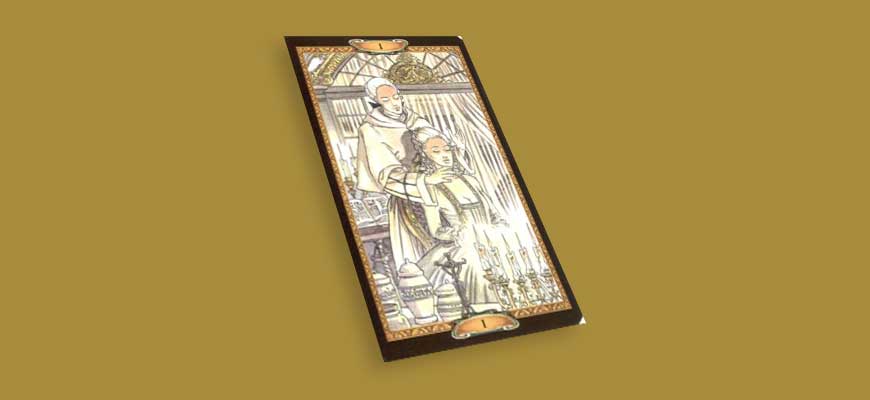
So, let’s start with the Magician. On this Tarot card of Casanova, we see a scene depicting the aristocrat Madame D’Urfe and the main character. D’Urfe was a passionate admirer of everything magical: she was fascinated by mysticism, Kabbalah, alchemy. In the biography of Casanova, there was an episode when he was mistaken for a great magician, and the venerable French nobility, of course, believed these rumors. It is not surprising that the aristocrat, fascinated by mysticism, wanted to meet the famous sorcerer one-on-one, confident that he knew one very important secret of alchemy, which he could share with her. In fact, Arkan shows us the relationship of two people, one of whom is the leader (in this case, Casanova himself), the second is the slave (woman). One partner, of course, if you dig deeper, is deceived, takes on faith everything that his counterpart says and does, and the second uses it. But in fact, both feel comfortable enough, because they evaluate the usefulness of this relationship from the point of view of reason.
On the Twelfth Arcana of Casanova’s Tarot, instead of the rather familiar static picture, we see incredible dynamism. I will not retell all the details of the story, a fragment of which is captured here, but I will say briefly: by the will of fate, Giacomo Casanova happened to be behind bars in Piombi prison, from which no one ever managed to escape. But the great adventurer thought out a very cunning plan, showed incredible patience and perseverance, and in the end he escaped, which, however, was complicated by many obstacles. On the Arcana, we see one of the most intense moments of this escape: Casanova descends on a rope through the roof of the prison into the Doge’s Palace. In fact, the card characterizes a dangerous situation, which at any moment can end in either a complete victory or a grandiose failure. It’s a bad idea to go back if the guards notice since then the hero will not only be taken into custody, but also extended; the rope can break – and then goodbye not only thoughts of freedom, but also your own life. Sacrifice in the Arcana is also partially present: in order to descend the rope, Casanova had to sacrifice his expensive, luxurious clothes, which after such a feat turned into rags.
the main characters of which are Giacomo Casanova and a young girl named Elena Morphy. It so happened that a chance meeting of a dirty, ragged Morphy with a famous ladies’ man radically turned the girl’s life. Casanova washed her, put her in order, and when he found out that she was a virgin, he decided to present her as a gift to the King of France. As you know, in those days, when a seductive heartthrob was making his adventurous adventures, virginity was at an incredible price, so Elena Morphy was lucky from a ragged beggar to become a real royal mistress. Here we see that both partners again receive certain benefits for themselves: Elena – a luxurious, rich life, Casanova – the location of the king, and with him the entire French nobility. the ragged Morphy with the famous ladies’ man radically turned the girl’s life. Casanova washed her, put her in order, and when he found out that she was a virgin, he decided to present her as a gift to the king of France. As you know, in those days, when a seductive heartthrob made his adventurous adventures, virginity was at an incredible price, so Elena Morphy was lucky from a ragged beggar to become a real royal mistress. Here we see that both partners again receive certain benefits for themselves: Elena – a luxurious, rich life, Casanova – the location of the king, and with him the entire French nobility. a ragged Morphy with a famous ladies’ man radically turned the girl’s life. Casanova washed her, put her in order, and when he found out that she was a virgin, he decided to present her as a gift to the King of France. As you know, in those days, when a seductive heartthrob was making his adventurous adventures, virginity was at an incredible price, so Elena Morphy was lucky from a ragged beggar to become a real royal mistress. Here we see that both partners again receive certain benefits for themselves: Elena – a luxurious, rich life, Casanova – the location of the king, and with him the entire French nobility. when a seductive heartthrob made his adventurous adventures, virginity was at an incredible price, so Elena Morphy was lucky from a ragged beggar to become a real royal mistress. Here we see that both partners again receive certain benefits for themselves: Elena – a luxurious, rich life, Casanova – the location of the king, and with him the entire French nobility. when a seductive heartthrob made his adventurous adventures, virginity was at an incredible price, so Elena Morphy was lucky from a ragged beggar to become a real royal mistress. Here we see that both partners again receive certain benefits for themselves: Elena – a luxurious, rich life, Casanova – the location of the king, and with him the entire French nobility.
since there are no heroes on them – we see only buildings, landscapes. These Arcana in Tarot Casanova include the Wheel of Fortune, Tower, Star, Moon and Sun. Let’s take a closer look at the Tower, since in this erotic deck it does not have the traditional aspect of destruction, here it is more of a constraint, loneliness, imprisonment. In the illustration of the XVI Arcana, the bell tower of the Church of Santa Maria della Formosa appears in all its gloomy glory against the background of the sky covered with gray clouds. On the one hand, the church is already certain restrictions imposed on a person, on the other hand, cloudy, depressive weather is a symbol of inner experiences, burdensome obligations that a person cannot cope with. The map will show relationships that seem strong and reliable in appearance, but in fact become a prison for the querent, imprisonment. This is a marriage that becomes a heavy shackle, any situations when it is difficult for a person to go beyond certain limits, a decadent state of mind and much, much more.
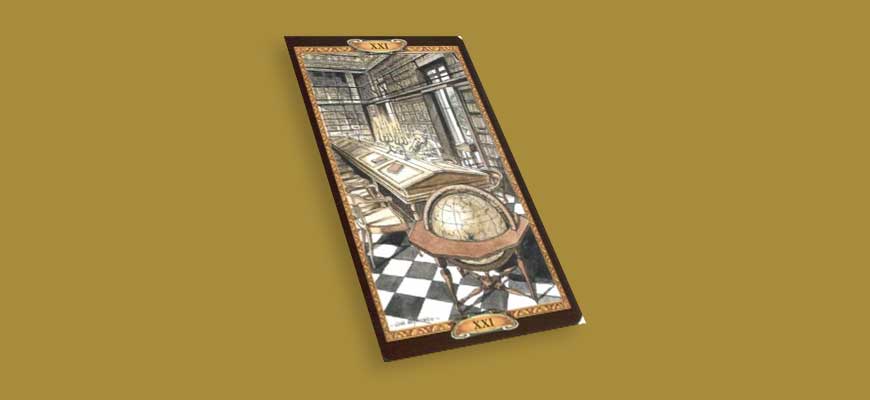
Finally, let’s analyze one more Major Arcana of Casanova’s Tarot, and then let’s go to meet the Younger. Let it be Peace. The map is the best way to show us the completion of a long journey, the culmination, the final stage, summing up. We see the great adventurer, who sits in a huge library inside the castle, which became his last refuge for a whole dozen years. Casanova is immersed in memories and painstaking work – he writes his memoirs, which later reflected not only fascinating travels, but actually told the story of an entire era. In my opinion, an excellent selection of the plot for the meaning of the Arkan Mir. which subsequently reflected not only fascinating travels, but actually told the story of an entire era. In my opinion, an excellent selection of the plot for the meaning of the Arkan Mir. which subsequently reflected not only fascinating travels, but actually told the story of an entire era. In my opinion, an excellent selection of the plot for the meaning of the Arkan Mir.
Minor Arcana
show all the same scenes from the memoirs of the famous seducer. By tradition, consider one number card of each suit. So, from the Wands, we focus on the Five. It is in many ways reminiscent of Waite’s classic fiery Five. On the Arcana, we see a duel between Casanova and the cavalier de Talvi. The quarrel between the men occurred over a mere trifle – a little comic liberty that the young rake allowed himself. This is not to say that the duel between the heroes is serious – it is also rather imitative in nature, which perfectly reflects the classic meaning of the card. The quarrel between the men occurred over a mere trifle – a little comic liberty that the young rake allowed himself. This is not to say that the duel between the heroes is serious – it is also rather imitative in nature, which perfectly reflects the classic meaning of the card. The quarrel between the men occurred over a mere trifle – a little comic liberty that the young rake allowed himself. This is not to say that the duel between the heroes is serious – it is also rather imitative in nature, which perfectly reflects the classic meaning of the card.
which really (judging by the memoirs) took place in Casanova’s life. On the Arcana, Giacomo makes love to two girls at the same time – these are the Savorgnan sisters. Here, all three get what they want at once: young beauties, each of whom liked a charming young man, and Casanova himself, who never misses the opportunity to conquer as many women as possible at once.
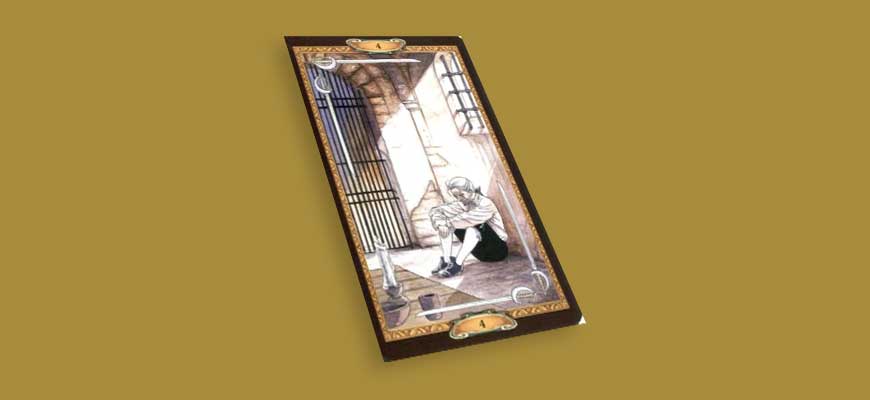
Perfectly played in Casanova Tarot and Four of Swords. Isolation, total loneliness, time constraints
The Eight of Pentacles of this erotic deck shows the very first sexual experience of Casanova – with the girl Bettina, the doctor’s sister, studying and living with whom young Giacomo spent his first years away from home. The card characterizes the first love, the first intimate relationship, a relationship in which one of the partners acts as a wise “teacher” (Bettina was several years older than Casanova), the other as a “student”.
Court Cards
The Arcana of the Court in Tarot Casanova are represented both by specific characters from “The Story of My Life” and by collective images. All of them are quite consistent with the classic types, but, of course, with key features that can be understood if you know the plot associated with this or that hero or heroine. However, it is quite possible to deal with the characters of the Court without remembering book stories: their poses, clothes, surroundings, colors of illustration will give a lot of interesting clues, so we will not dwell on them in detail, otherwise my article risks approaching in volume to the very memoirs of the Italian ladies’ man. associated with this or that hero or heroine. However, it is quite possible to deal with the characters of the Court without remembering book stories: their poses, clothes, surroundings, colors of illustration will give a lot of interesting clues, so we will not dwell on them in detail, otherwise my article runs the risk of getting closer in volume to the very memoirs of the Italian ladies’ man. associated with this or that hero or heroine. However, it is quite possible to deal with the characters of the Court without remembering book stories: their poses, clothes, surroundings, colors of illustration will give a lot of interesting clues, so we will not dwell on them in detail, otherwise my article runs the risk of approaching in volume to the very memoirs of the Italian ladies’ man.
Peculiarities of card interpretation
As I already mentioned, for a deep study of the Tarot of Casanova, some knowledge of the original source is still required – otherwise, many Arcana will seem incomprehensible. Of course, you can use intuitive reading or focus on the classics, but it seems to me that then the whole point of practicing with this deck is simply lost. Better to take the time and re-read the stories, at least in a short retelling. Reverse cards are not used in the Casanova Tarot.
Which deck is suitable for consideration
The Casanova Tarot is considered a highly specialized deck aimed solely at viewing love relationships. However, in my opinion, it is also very easy to analyze relationships in general: business, friendly.
Who can use the card data
Tarot Casanova can be safely recommended to those who are looking for an interesting, understandable and versatile deck for viewing issues of love, marriage, sex, as well as collectors.
Recommended reading for familiarity with the deck
If you are too lazy to re-read the thick work of Giacomo Casanova himself, I highly recommend buying at least a book by our Russian tarologist Elena Ledney entitled “Love, Intrigue, Erotica in Casanova’s Tarot.” Elena is simply magnificent, colorful, living language, describes not only the meanings of each Arcana in describing relationships, thoughts, feelings, sexual aspect, as advice and warning, but also talks in detail about the plots and stories associated with it, examines the details of the clothes surrounding furnishings, flowers, Venetian masks. In this book, you will even find the probability of conception, which each card can indicate. So it is this huge and work that I sincerely advise to all those who decided to try to deal with this unusual erotic deck – Casanova’s Tarot.
